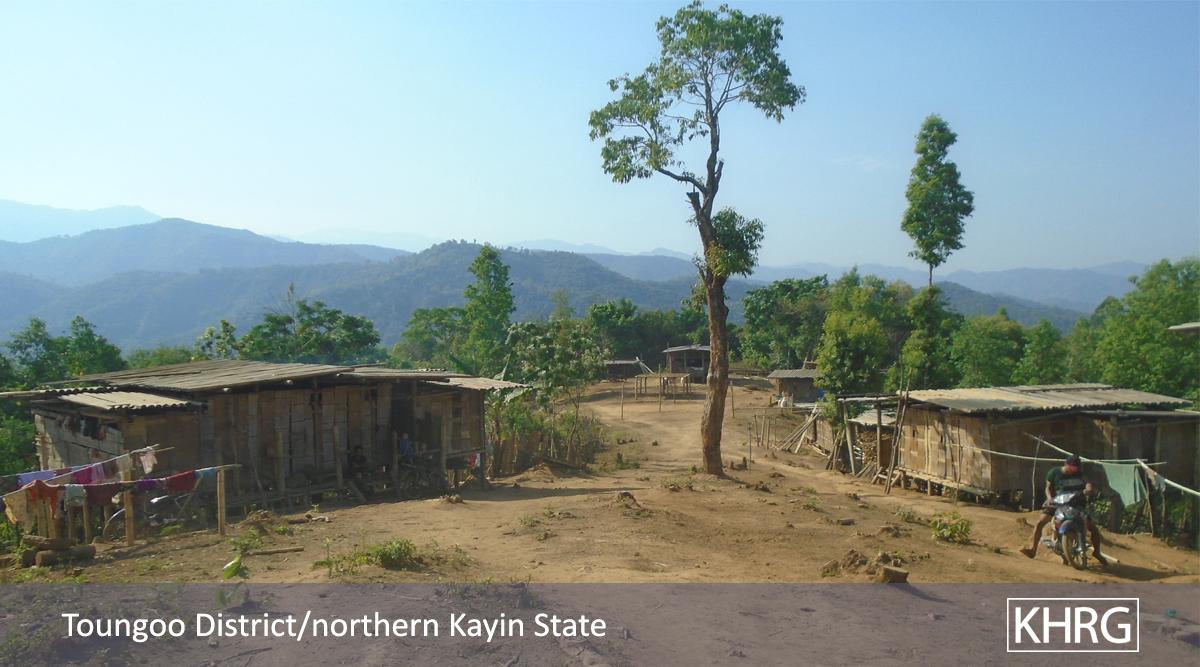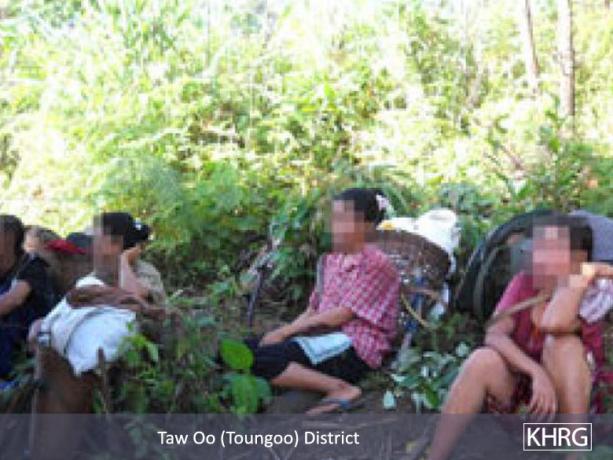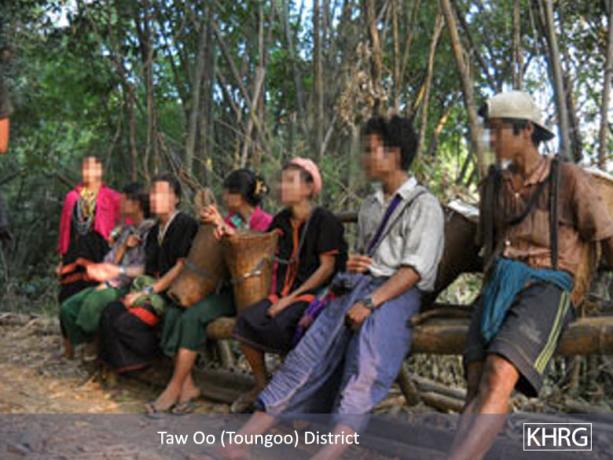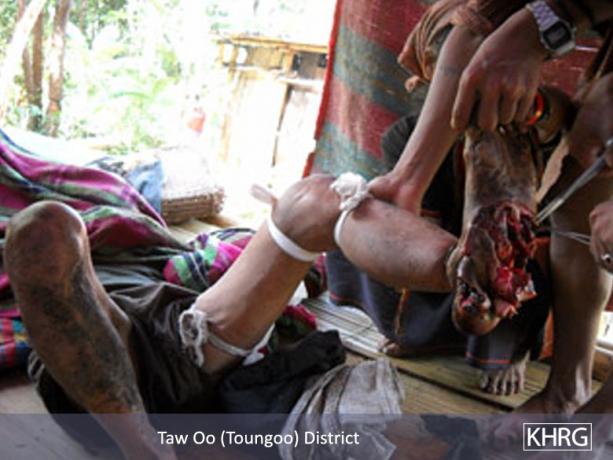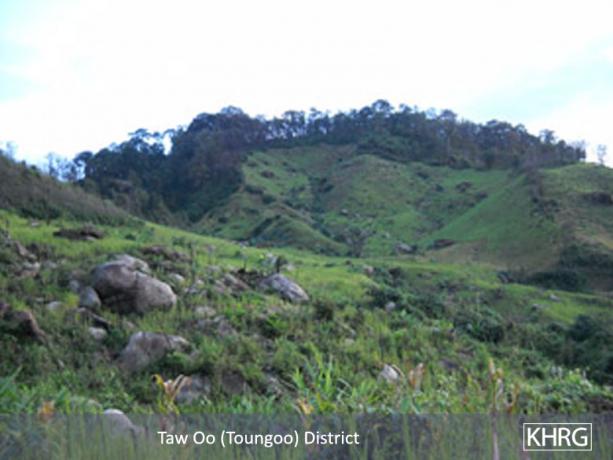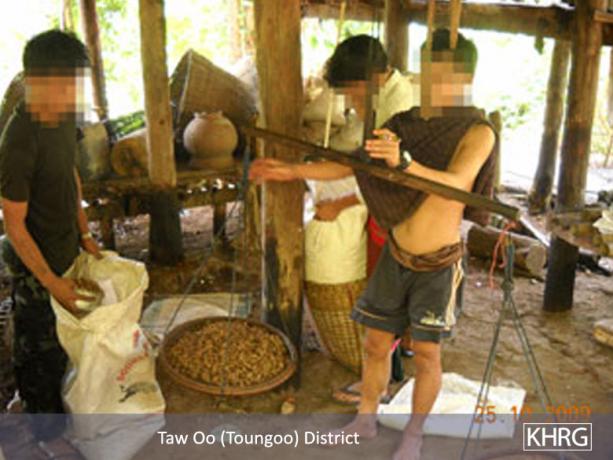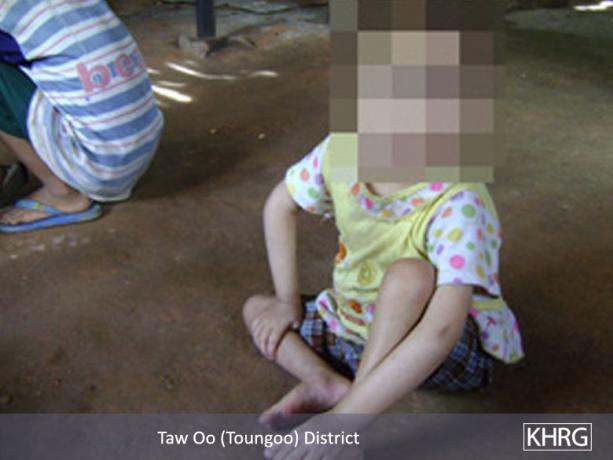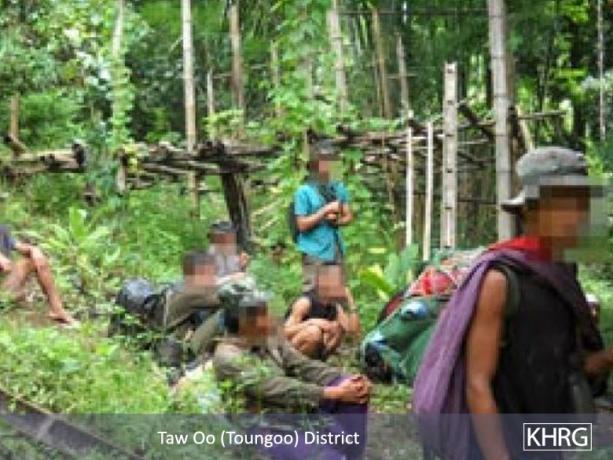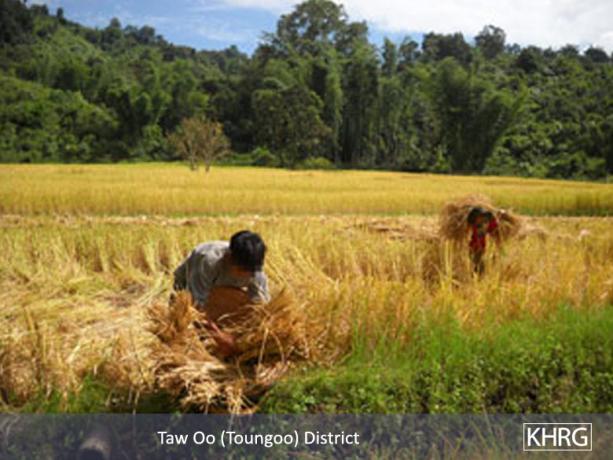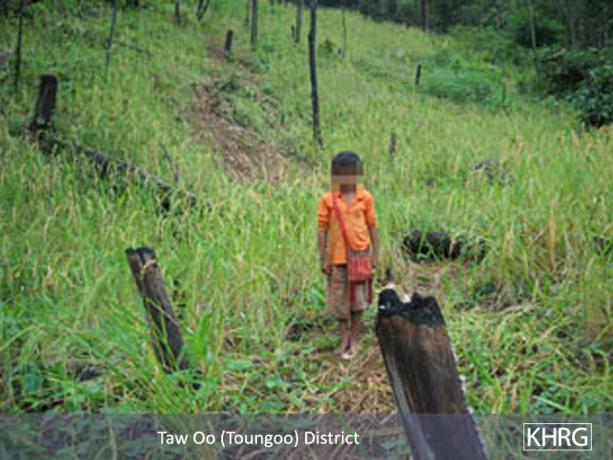This field report documents the continuing and worsening demands for forced labour and restrictions on movement and trade imposed on villagers in Toungoo District by the SPDC army. These exploitative and restrictive practices undermine the livelihoods of both individuals living under SPDC control and villagers who have opted to live in hiding. Heavy demands for forced labour limit the time that villagers in relocation sites or SPDC-controlled areas can devote to securing their livelihoods; this strain is exacerbated by increasing restrictions on villagers' freedom to travel for farming and trade, the latter of which is essential for obtaining basic foodstuffs and other necessities in many parts of Toungoo. This situation in turn reduces the availability and accessibility of essential food and medicines to villagers in hiding, who continue to resist SPDC exploitation despite grave risks to their physical security. This report covers incidents between June 2009 and January 2010.
Since early 2009, SPDC units deployed in Toungoo District have been highly active and have rotated more frequently than in previous years - as often as once or twice a month, according to KHRG's researchers. This trend appears set to continue in 2010, as fresh battalions from Military Operations Command [1] (MOC) #7[2] have been rotated to replace MOC #5, which had operated in Toungoo since early 2007.[3] This constant troop movement has led to increased demands for forced labour and instances of arbitrary taxation, as military units typically require villagers to engage in forced portering of equipment and rations as well as construction work on new camps whenever troops are redeployed to a new location. In addition to labourers demanded for camp construction, recently arrived army units often require villagers to find, prepare, and deliver building materials for their camps such as bamboo poles and thatch shingles; these activities constitute forms of forced labour, as villagers receive little or no remuneration and must spend crucial time away from their own fields and other livelihoods activities. Once an army unit has settled into a new area, local civilians are frequently further obliged to provide on a regular basis fixed amounts of foodstuffs and a certain number of labourers to carry out maintenance of camp facilities and other tasks such as collecting water, cooking, and serving as messengers or guides. Incidents of forced labour continue to be widely reported throughout Toungoo District.
In addition to the established pattern of the SPDC Army's heavy demands for forced labour from villages under its control, KHRG's researchers have reported that increasingly stifling movement and trade restrictions have been enforced against villagers since April 2009. These restrictions disrupt villagers living in army-controlled areas from engaging in their usual farming and trading activities, exacerbating the strain on livelihoods created by forced labour requirements. Furthermore, such restrictions inevitably undermine the capacity of villagers in hiding sites, referred to as Internally Displaced Persons (IDPs), to sustain themselves by preventing crucial commerce and especially the trade of medicines and food between villages under SPDC control and communities in hiding. When considered against the backdrop of the army's drive to force villagers from contested areas into relocation sites or military-controlled villages where they can be more easily controlled as well as tapped for extraction of resources and labour, it is difficult not to see the ever-tightening movement and trade restrictions as designed to target villagers in hiding.[4]
Operating areas for battalions in Toungoo District as of January 2010 are shown in the table below:
|
#
|
New SPDC Unit
|
Operating Area
|
|
1
|
MOC #7 |
Headquartered in Kler La |
|
2
|
LIB #427 |
Gkaw Thay Der to See Kheh Der |
|
3
|
LIB #250 |
Plaw Moo Der to Buh Sah Kee |
|
4
|
LIB #421 |
Klaw Mi Der to Play Hsa Loh |
|
5
|
LIB #424 |
Th'Ay Hta, Ko Day, Gklay Soh Kee |
|
6
|
LIB #245 |
Bpeh Leh Wah, Gkaw So Koh, Kler La |
|
7
|
LIB #426 |
Ker Weh, Gk'Thaw Bpweh, K'Thwee Dee, Day Loh Toh |
|
8
|
LIB #261 |
Htee Nya Bpeh Loh |
Forced labour and arbitrary taxation
In areas of Toungoo District controlled by the SPDC, forced labour continues to be the most prevalent form of human rights abuse committed against villagers by the armed forces.[5] This is a direct consequence of the steadily increasing militarization and consolidation of military control of Toungoo in recent years, combined with the need for SPDC Army units deployed to Karen state to "live off the land" by exploiting the civilian population to satisfy basic logistical needs.[6]Although the SPDC authorities often claim that forced labour is for the development of Burma, and villagers should therefore participate, forced labour and arbitrary taxation entailing forced labour appear entirely geared towards supporting the ongoing militarization of Toungoo District and indeed Karen State. Involuntary labour on roads (which are often used by the military to exert control over the civilian population), on military camps, as porters, and in the production of food and other supplies all facilitate the continued presence and operations of military battalions in Toungoo.
Forced labour takes various forms, including: messenger duty (set tha)[7] for army units; building, maintaining, or repairing military camps and roads; serving as porters or guides for military units; and forced recruitment into the armed forces. The extraction of material support from nearby villages by military units is often referred to as arbitrary 'taxation', yet it also constitutes a significant and particularly pernicious form of forced labour. Villagers and communities must not only divert finite time, energy and resources away from their own livelihoods activities to provide the military with food, building supplies or money; but they also receive only token or no remuneration at all for the substantial inputs of labour involved in finding, producing, and transporting to military camps whatever supplies are demanded of them.
Movement and trade restrictions
Movement and trade restrictions are imposed on certain villages by SPDC Army officials ostensibly to cut off support for armed opposition groups, and for security while SPDC units are active in a given area.Such restrictions, however, are devastating for both villages under military control and for villagers that have opted to flee to hiding sites in areas outside of SPDC control. A range of measures are employed to limit the movement of individuals in Karen areas, including: imposing curfews, fencing fields and villages, enforcing restrictions on road travel to and from certain towns or areas, establishing security checkpoints on roads, and requiring permission documents for travel outside of villages which must be applied for and purchased on a regular basis. At the stricter end of the scale, travel in and out of certain villages is entirely forbidden even during the day, military personnel lay landmines to enforce off-limits areas,[10] and villagers violating these restrictions risk being shot on sight. Trade restrictions entail limits or outright bans on villagers buying and transporting certain products such as medicines, batteries, and staple food products in restricted travel areas.
Finally, villagers living in hiding sites beyond regular SPDC control face similar livelihoods problems stemming from limitations on their access to markets, where they can procure food, trade crops such as cardamom harvested in jungle plots and purchase essential items such as medicines.[11] Most importantly, displaced villagers essentially live in constant violation of official movement restrictions: the SPDC Army does not draw a distinction between unarmed villagers in hiding and KNLA soldiers.IDPs in Toungoo district therefore risk being shot on sight any time they encounter SPDC Army soldiers while travelling between hiding sites and jungle plots, returning to their former villages to recover hidden food supplies and other materials, or going to trade for essential items with villagers from SPDC controlled areas.[12]The impact of such restrictions on villagers cannot be properly understood in isolation from the civilian context of Toungoo District. In the hilly areas subject to the most severe restrictions, the soil does not support rice production, so villagers raise crops such as sesame, betelnut, betel leaf, dog fruit, mangosteen, and cardamom. They then sell or trade their produce with villagers living along main roads or near towns, such as Kler La, Gkaw Thay Der, Gklay Soh Kee and Than Daung city, in order to acquire rice and other staple items. Inter-village travel restrictions naturally obstruct this commerce and prevent the procurement of essential food and other products. Further, where villagers' freedom to travel to plantation fields outside of their villages is limited, or permission from SPDC authorities is required, regular planting, maintenance, and harvesting activities are disrupted and the quality and value of the crop diminished. Poorer villagers, who do not have their own lands and must do paid labour on plantations owned by others, are dependent on their daily salary to feed themselves and their families. Movement restrictions obstruct how regularly they may work and receive payment, and permission fees represent a significant financial burden for them.
Restrictions on travel and trade have been frequently imposed by from the Kler La, Tantabin Township headquarters of the SPDC Military Operation Command deployed to Toungoo. From 2007 through 2009, this was MOC #5, commanded since May 2009 by Khin Maung Hsint, which was replaced in January 2010 by MOC #7 under the command of Kyaw Myo Aye. KHRG's researchers have reported significant movement restrictions since April 2009 in villages along the main road leading west to Toungoo from Kler La, as well as in and between the villages near Kler La. Communities in these areas are frequently subject to individual curfews, and blanket travel restrictions whenever SPDC units are active.
On November 20th, 2009, MOC #5 began blocking villagers from Kler La and Gkaw Thay Der, Tantabin Township from travelling on the road to Toungoo. This occurred at a time when such a large number of individuals from areas around Kler La and Gkaw Thay Der were suffering from the flu and other winter illnesses that the Kler La hospital was full to the point of turning away patients. The movement restrictions prevented individuals from villages without medical facilities or medicines from travelling to Kler La to seek treatment, while preventing individuals already in Kler La but not admitted to the hospital from travelling to other towns or cities to get treatment or medicines. The situation was reported to SPDC officials but the restrictions were not adjusted or relaxed.[13] Such restrictions, which are particularly harmful for vulnerable populations such as children in need of medical treatment, are considered a 'grave violation' of children's rights and explicitly condemned by United Nations Security Council Resolution (UNSCR) 1612.[14]
In some parts of Toungoo District, for example in the Maw Nay Pwa area, individuals violating movement restrictions have continued to face severe punishments and exorbitant fines, regardless of their reasons for doing so. On June 24th and June 26th 2009, SPDC soldiers from MOC #5 arrested Saw K---, a 32-year-old villager from Y---, and Saw P---, a 26-year-old from P--- village, Tantabin Township, for violations of movement restrictions, and fined them 500,000 kyat (US $495)[15]each. Villagers interviewed by KHRG said that though fines totalling 1,000,000 kyat (US $989) had been paid, the individuals had not yet been released. SPDC soldiers also arrested Maung S--- from Y--- for disobeying movement restrictions, but released him after receiving a guarantee from Y--- village head Naw H--- that Maung S--- was a farmer from her village. In parts of Toungoo District that are contested or close to contested areas, all villagers disobeying movement restrictions continue to risk incurring heavy fines, detention and physical abuse by soldiers, physical injury from landmines, and being shot on sight by SPDC patrols.
All individuals passing through the checkpoints must also carry documents granting them permission to travel, documents that must be applied for, purchased, and repeatedly renewed. A letter for travel between Than Daung city and Ker Weh, for example, costs 2,000 kyat (US $1.98). Furthermore, different permissions are needed for different forms of travel; in Maw Nay Pwa, for instance, the SPDC Army unit based in Play Hsa Loh, Tantabin Township requires villagers to purchase a letter every three weeks just to travel or work outside, and an additional permission to travel to Tha Pyay Nyunt to obtain rice, salt, and fish paste, staple food items which are unavailable in many smaller villages. Permissions are not always granted automatically or on a regular basis, and villagers have reported waited two to three weeks to receive approval. An unpredictable waiting period can be devastating to villagers whose livelihoods are rooted in trade in agricultural products, particularly products that are perishable. Villagers in relocation areas at Play Hsa Loh have reported that the irregular approval of their travel permission documents has resulted in their durian, mangosteen and betel leaf crops rotting as they awaited permission to take them to the market. They had been told that they would be "fined" 1 viss (1.6 kg. / 3.6 lb.) of chicken if they were caught travelling without an up-to-date permission document.A large number of checkpoints have been established along the main roads of Toungoo District to enforce travel restrictions, each of which presents a further deterrent or financial obstacle to travel and trade. At each checkpoint along the road between Toungoo and Gkaw Thay Der,[16] SPDC soldiers require passing motorcycles to pay 1,000 kyat (US $.99) and trucks 5,000 kyat (US $4.95); on the road between Than Daung city and Ker Weh motorcycles must pay 1,500 kyat (US $1.48) at each checkpoint. Villagers travelling these routes to engage in trade say that they have been obliged to surrender some of their goods as "tax". Locals have reported that checkpoints in towns with SPDC Army camps based near main roads check all passing individuals and vehicles and demand taxes, notably in the camps at Kler La, Bpeh Leh Wah, 20 mile, 18 mile, 13 mile, 4 mile, Than Daung, Sway Nyaw, Bpay, and Toungoo (at the Say Toung Myit bridge).
Villagers and vehicles passing through checkpoints may also be searched for restricted items such as medicines, batteries, and rice. Villagers have reported to KHRG field researchers that SPDC soldiers have told them that more stringent travel restrictions and trade limits on strategic goods have been imposed to prevent villagers under SPDC control from trading with communities in hiding: an important villager resistance strategy noted in previous KHRG reports.[17] Those living in relocation sites have been told they may only purchase a limited amount of rice when trading. Locals visiting the market at Tha Pyay Nyunt, Tantabin Township, for example, are not permitted to buy more than four bowls of rice (6.25 kg. / 13.8 lb.), although some have been able to pass checkpoints carrying more than the permitted amount by bribing low-ranking soldiers. In comparison, restrictions on medicines have been strictly enforced. Villagers face fines or imprisonment for violating the prohibition on carrying medicine; KHRG field researchers have been told that even a single tablet of Paracetamol can attract a fine. In November 2009, a villager from Bpeh Gkaw Der, Than Daung Township reported being fined 600,000 kyat (US $593) for having two small bottles of injectable medicine; if unable to pay, he faced three years in prison.
Between August 10th and October 1st 2009, for instance, villagers in hiding west of the Day Loh River in Than Daung Township told KHRG field researchers that they were anticipating an upsurge of SPDC activity coinciding with the end of the rainy season in October and the ensuing harvest. In the past, this group has frequently had its farming and cardamom-growing activities disrupted by SPDC patrols at this important time of year, and the villagers said that they were making preparations to minimize the damage to their harvest this year. Also during September and October 2009, villagers in hiding sites south of the main road heading east from Kler La to Mawchi told KHRG that they had to move their villages; they had moved following shelling by SPDC units attempting to clear the area prior to post-rainy season road work and delivery of rations to troops deployed to patrol the area between Hsaw Wah Der and Ha Htoh Per in Tantabin Township.As noted above, villagers who have chosen to reside in hiding sites in areas beyond state control face particularly acute insecurity, as the SPDC's movement restrictions effectively outlaw their everyday livelihood activities. Individuals from these communities typically farm less productive but labour-intensive hill or jungle plots that require constant maintenance. They raise crops such as cardamom that can be easily transported and traded for food and other essential items with villagers living in or near army-controlled areas. In addition to the reduced availability of and access to key goods due to travel and trade restrictions imposed on villagers from SPDC-controlled areas, villagers in hiding further risk maiming by landmines, detention, torture, and being shot on sight whenever they engage in everyday farming activities, attempt to transport and trade their crops, or visit secret locations where they have stored food. Higher levels of SPDC activity in a given area, for example an increase in the frequency of patrols, may result in villagers travelling less often to tend to their crops, thereby reducing the yield and value of their produce, or being unable to travel to a market with already-harvested crops. Alternatively, villagers may attempt to harvest their crops too early, in anticipation of SPDC activity, since soldiers typically burn any fields or food stores they come across during patrols in areas not under SPDC control.[18] Increased army activity during key points in the agricultural cycle, for example prior to and during planting and harvesting periods, disrupts farming and represents a serious threat to the livelihoods of displaced communities, as their jungle crops are their main source of income to secure food and other important items such as medicine.
The cumulative impact of restrictions on movement and trade on civilians has been devastating, in areas both under and beyond SPDC control. For villagers under military control, overwhelming demands for forced labour compounded by heavy-handed restrictions on their freedom of movement greatly undermine their livelihoods, and may lead some to consider life in hiding, although certain restrictions, such as evening curfews and strict limits on carrying uncooked rice, appear designed to pre-empt this form of resistance. For villagers in hiding, movement and trade restrictions target their ability to survive beyond SPDC control, and therefore their resistance to exploitative abuse by the SPDC. Furthermore, the overall obstruction of food production and commerce arising from severe movement restrictions also threatens to exacerbate ongoing food shortages, precipitated by decades of militarization, affecting civilians in Toungoo District.[20]On January 19th 2010, SPDC soldiers (probably from LIB #427, MOC #7)[19] from the camp at Naw Soh, Tantabin Township entered K--- village on patrol. K--- is located near the army camps in Naw Soh and See Kheh Der, but is not under full SPDC control and therefore villagers in this area are subject to the shoot on sight policy. On this occasion, three villagers were shot on sight, including 35-year-old Saw Htoo Nay Wah, a married father of two children, who died on the spot. The soldiers then set about destroying the villagers' food stores: they burned down Naw Gkay Lay's rice storage barn with 25 baskets of paddy (525 kg. / 1150 lb.) and destroyed 15 big tins (157.5 kg. / 345 lb.) of Saw Muang Hsih's paddy. Villagers in this area had to flee quickly into the jungle and are now dealing with a serious shortage of food and clothing. Some villagers were unable to carry anything with them, and are surviving with the support of their neighbours; others had to leave behind valuable goods as well as stores of agricultural products, such as dried betelnuts, which they would have sold or traded for food.
Conclusion
Villagers across Toungoo District, whether living in hiding or under military control, continue to face regular and large-scale human rights abuses as they are increasingly affected by SPDC Army operations designed to consolidate its presence in, and control of Toungoo. This presence is sustained through routine exploitation of the civilian population. Individuals living in relocation sites, near military encampments and in other areas fully controlled by the military, face constant demands for forced labour that significantly interfere with their livelihood activities by consuming their time, energy and resources. Increasingly stringent movement and trade restrictions have furthermore affected many of these villagers' freedom to engage in farming and trade, further undermining livelihoods and access to essential food items and vital services such as health care. These restrictions also effectively target the villagers in Toungoo District that have chosen to flee from the SPDC Army's systematic exploitation and forced relocation campaigns and live in hiding in sites beyond military control: not only by criminalising such activities as travelling to work on jungle farms and engaging in trade with villagers from military-controlled areas to obtain basic foods and medicines; but also by obstructing farming, food production, and trade in controlled areas to such an extent that there is a shortage of necessity items, and therefore nothing to trade with communities in hiding. Ironically, while the restrictions imposed by the SPDC Army have made survival and resistance increasingly difficult for villagers in hiding, its efforts to achieve comprehensive control and exploitation of villagers in areas under its control make resistance, flight, and survival in hiding increasingly attractive.
Footnotes:
[1] A Military Operations Command (MOC) typically consists of ten battalions. Most MOCs have three Tactical Operations Commands (TOCs), made up of three battalions each.
[2] Battalions from MOC #7 have also been reported committing abuses in Lu Thaw Township, just south of Toungoo in Papun District. See, "SPDC mortar attack on school in Papun District" KHRG, February 2010.
[3] For more on MOC #5, which had been notorious amongst Toungoo civilians for its abuse of villagers, first under commander Kaung Mya and then under commander Khin Maung Hsint, see "Patrols, movement restrictions and forced labour in Toungoo District," KHRG, September 2009; "SPDC spies and the campaign to control Toungoo District," KHRG, March 2008; "Provoking Displacement in Toungoo District: Forced labour, restrictions and attacks," KHRG, May 2007.
[4] For more on tactics that target civilians and villagers, see especially: "Village Agency: Rural rights and resistance in a militarised Karen State," KHRG, November 2008, pp. 116-131. For more on the use of travel and trade restrictions to target villagers in hiding in other parts of Karen State, see: "Starving them out: Food shortages and exploitative abuse in Papun District," KHRG, October 2009.
[5] Background on the frequency, nature, and consequences of forced labour in Toungoo District is available in:"Patrols, movement restrictions and forced labour in Toungoo District," KHRG, September 2009; for a more general summary of the types of forced labour demanded of villagers by the SPDC in Burma, see: "Village Agency," pp.43-63.
[6] This 'live off the land' or ‘self-reliance’ policy became explicit in 1997, when Burma's War Office issued an order instructing the country's 12 Regional Commanders that troops "were to meet their basic logistical needs locally, rather than rely on the central supply system." See, Andrew Selth, Burma's Armed Forces: Power Without Glory, Norwalk: Eastbridge, 2002 p. 136. See also, Mary Callahan, "Of kyay-zu and kyet-zu: the military in 2006," pp. 36-53 in Monique Skidmore and Trevor Wilson (eds.), Myanmar: The State, Community and the Environment, Canberra: Asia Pacific Press, 2007 p. 46.
[7] Set tha; Forced labour as a messenger stationed at army camps or bases and serving as a go-between to deliver orders from army officers to village heads, but also involving other menial tasks such as cooking, collecting water and cutting firewood.
[8] LIB #537 of TOC #1, MOC #5, led by Commander Kaung Htet, was based in Play Hsa Loh during 2009. KHRG researchers report that LIB #537 has recently been rotated out of Toungoo, and LIB #421 of MOC #7 now operates between Play Hsa Loh and Klaw Mi Der.
[9] See: "Abuse, Poverty and Migration: Investigating migrants’ motivations to leave Burma," KHRG, June 2009.
[10] Villagers in northern Karen State continue to be at risk from landmines laid by the SPDC and KNLA. Landmine Monitor’s 2009 country report for Burma notes that both of these actors manufacture and use landmines widely, and that “every township” of Karen State is hazardous for civilians. See, "Landmine Monitor Report 2009," Landmine Monitor, 2009, pp.1029-1040.For details on the types of landmines used by the SPDC and KNLA, see "Insecurity amidst the DKBA – KNLA conflict in Dooplaya and Pa’an districts," KHRG, February 2009. In a particularly shocking example of the use of landmines against civilians, on September 17th 2009, DKBA soldiers temporarily quartered in a village in Papun District mined approaches to the village, including placing at least two mines directly in front a village primary school. See, "Grave Violations: Assessing abuses of child rights in Karen areas in 2009," KHRG, January 2010, pp.8-9.
[11] Trade between military-controlled and displaced villages has been highlighted as a key resistance strategy for villagers seeking to escape overwhelming exploitation by the SPDC. See, "Village Agency," pp.140-142.
[12] For more background on the use of movement restrictions to control the civilian population of Toungoo, see "Attacks, forced labour and restrictions in Toungoo District," KHRG, July 2008.
[13] Such restrictions limiting access to medical services took on added international importance in Papun District during September 2009, when at least 1,476 villagers were affected by what was eventually determined to be rapidly progressing human influenza with an "unusual seasonal peak.” See, "Statement by BPHWT regarding on FLU out-break in Papun District, Karen State, Burma," Back Pack Health Worker Team, October 2009. On file with KHRG. Before lab tests could be run to establish the nature of this flu, at least one group speculated that it could be H1N1 ‘Swine Flu’. See, "Serious Illness Hits Kachin and Karen Children," Burma Campaign UK," September 2009. For an interesting account of the medical response from health organisations operating out of Thailand, see “Local Medics Respond to Flu Outbreak in Karen State,” The Irrawaddy, February 2010.
[14] For more on the way UNSCR 1612 prohibits restrictions on access to humanitarian supplies, see "Grave Violations: Assessing abuses of child rights in Karen areas during 2009," KHRG, January 2010.
[15] All conversion estimates for the kyat in this field report are based on the fluctuating informal exchange rate rather than the SPDC government’s official fixed rate of US$1 = 6.5 kyat. As of February 17th 2010 this unofficial rate of exchange was US$1 = 1011 kyat, and this figure is used for all calculations above.
[16] The Thai Burma Border Consortium (TBBC) gives the figure of 13 checkpoints, each requiring a “toll” on the road between Kler Lah and Toungoo; total fees of 190,000 kyat (US$188) were required for a return trip on this road. See: "Protracted Displacement and Militarisation in Eastern Burma," TBBC, November 2009, p.20. Note that the number of checkpoints may fluctuate according to military activity on the road and the establishment of impromptu checkpoints by some army units.
[17] See above note 11.
[18] Note that villagers in hiding are usually aware of SPDC troop movements, and have developed their own advance warning systems in order to enhance their security living beyond SPDC control. See: "Village Agency," p.137.
[19] The researcher reporting this incident did not specify whether LIB #427 was responsible for the attack on K---. However, according to KHRG’s information, since the beginning of 2010 LIB #427 has been deployed between Gkaw Thay Der and See Kheh Der along the Gklay Soh Kee – Buh Sah Kee road (see the table listing the new SPDC units in Toungoo District in the introduction of this report). Since Naw Soh and K--- are located along the Gklay Soh Kee – Buh Sah Kee road, and between Gkaw Thay Der and See Kheh Der, LIB #427 was likely the unit that carried out the attack.
[20] For more on food insecurity in northern Karen State, see: "Food Crisis: The Cumulative Impact of Abuse in Rural Burma," KHRG, April 2009; and: "Attacks, Killings, and the Food Crisis in Toungoo District," KHRG, August 2008

